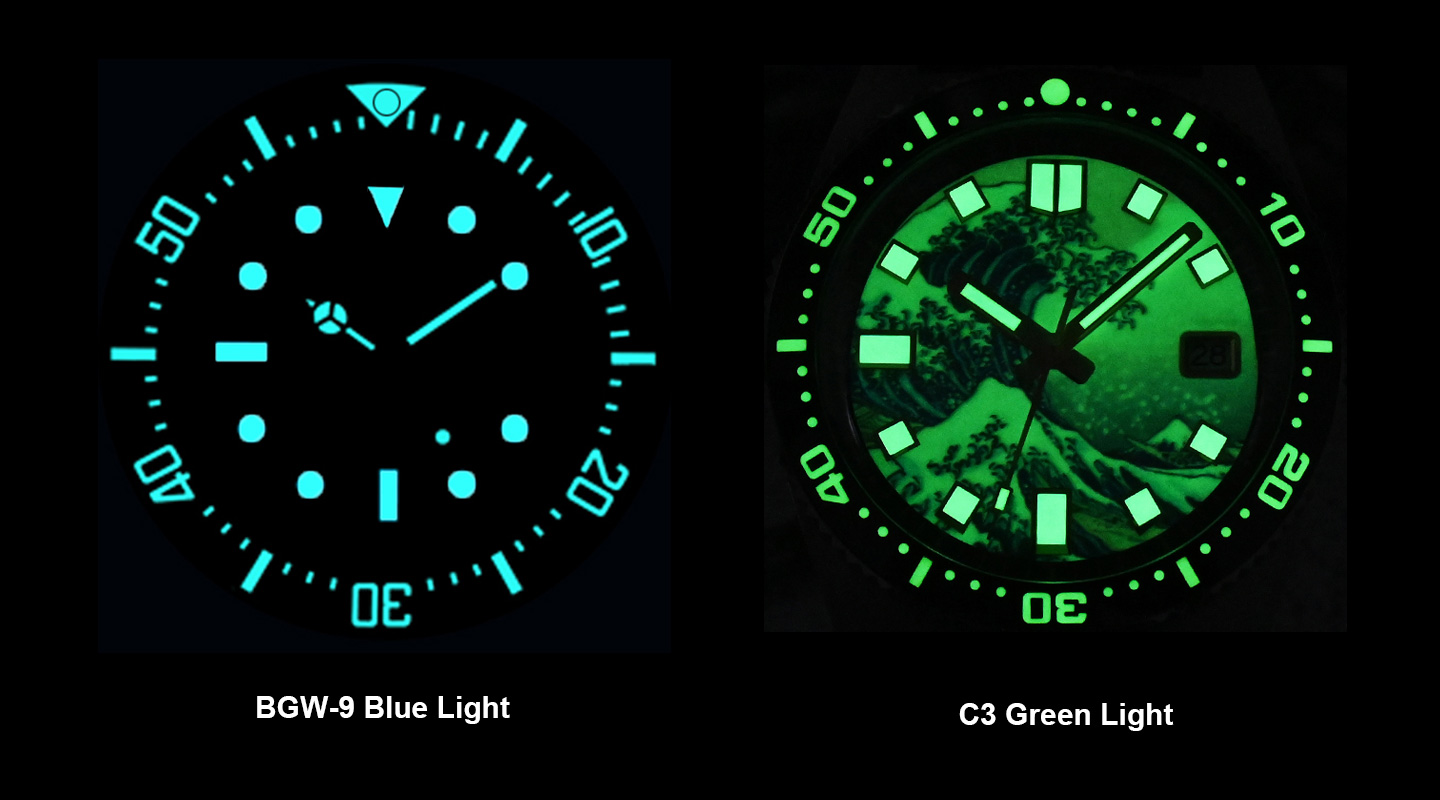Dive watches require luminous materials with high brightness, long-lasting performance, water resistance, and safety to ensure readability in underwater darkness. Below is a detailed analysis of common luminous materials and their distinctions:
1. Tritium Tubes (e.g., Trigalight, BetaLight)
Luminescence Mechanism: Self-luminous material that uses beta decay of tritium (³H, a hydrogen isotope) to excite phosphor coating inside the tube, requiring no external light source.
Key Features:
Safety: Tritium has low radioactivity, and beta particles have minimal penetration. Sealed in glass tubes, they meet safety standards like ISO, posing no harm to users.
Brightness & Longevity: Emits light continuously for 10–12 years (tritium’s half-life is 12.3 years), with slow decay and no need for recharging. Initial brightness is lower than photoluminescent materials.
Colors: Commonly green or blue, determined by the phosphor type.
Applications: High-end dive watches (e.g., Luminox, Ball Watch), suitable for long-term underwater or light-free environments.
2. Super-LumiNova (Strontium Aluminate-Based Phosphor)
Luminescence Mechanism: Photoluminescent material that absorbs UV or visible light, stores energy, and releases it as fluorescence.
Key Features:
Safety: Non-radioactive and eco-friendly, applied directly to dials or hands.
Brightness & Longevity: High initial brightness after charging, but decays rapidly (noticeable dimming within hours). Requires regular recharging (e.g., sunlight, artificial light).
Technical Iterations:
C3 version: Green glow, higher brightness.
BGW9 version: Blue glow, slower decay.
Latest versions: Nanotechnology enhances energy storage efficiency and longevity.
Applications: Mainstream dive watches (e.g., Rolex Submariner, Omega Seamaster), convenient for daily use with easy recharging.

3.Tritium and Traditional Radioactive Materials (e.g., Radium, Tritium Paint)
Luminescence Mechanism: Early materials mixed tritium or radium with phosphors, using radioactive decay to excite fluorescence.
Key Features:
Safety Concerns: Radium’s high radioactivity led to its discontinuation. Tritium paint, with lower radioactivity, was used in military watches (e.g., early Rolex MilSub) but has been mostly replaced by tritium tubes.
Brightness: Continuous glow, but safety controversies around radioactive materials drove the development of non-radioactive alternatives.
4. Zinc Sulfide (ZnS)
Luminescence Mechanism: Early photoluminescent material with low brightness and poor longevity.
Applications: Only found in vintage dive watches; obsolete in modern timepieces.
5. Material Comparison Table
|
Dimension |
Tritium Tubes (Trigalight) |
Super-LumiNova (Photoluminescent) |
Traditional Radioactive Materials (Radium, Tritium Paint) |
|
Luminescence Mechanism |
Self-luminous (tritium decay excites phosphor) |
Photoluminescent (absorbs light, then glows) |
Self-luminous (radioactive decay excites phosphor) |
|
Radioactivity |
Low (safe when sealed) |
None |
High (radium) / low (tritium paint) |
|
Initial Brightness |
Medium (≈1/3 of Super-LumiNova) |
High (intense glow after charging) |
Medium (tritium) / high (radium, discontinued) |
|
Longevity |
10–12 years (slow decay) |
Hours (requires recharging) |
Tritium paint: ~10 years; radium: obsolete due to rapid decay |
|
Maintenance |
No recharging needed, maintenance-free |
Requires light recharging |
None (but high safety risks) |
|
Cost |
High (complex tritium tube encapsulation) |
Medium (high mass-production) |
Low (obsolete) |
|
Typical Brands |
Luminox, Ball, SEIKO Prospex (select models) |
Rolex, Omega, Longines, Tudor |
Vintage watches (e.g., 1960s Rolex, Blancpain) |
6. Special Requirements and Selection Logic for Dive Watches
Underwater Environment Adaptation:
Tritium tubes: No external light needed, ideal for deep-sea long-term operations (e.g., professional divers), with stable brightness.
Super-LumiNova: Requires full charging before diving, suitable for recreational diving (recharged during surface activities), with superior initial brightness.
Safety and Durability:
Modern dive watches prioritize non-radioactive materials (e.g., Super-LumiNova) or sealed radioactive materials (tritium tubes) to avoid paint flaking risks.
Tritium tube's hermetic design makes them more resistant to water pressure and corrosion, suitable for extreme environments.
Technological Trends:
Brands increasingly use improved photoluminescent materials (e.g., Rolex's Chromalight blue lume), extending glow time and optimizing colors (e.g., teal is more visible than traditional green).
Some brands experiment with hybrid technologies (e.g., tritium tubes + photoluminescent coatings) to balance longevity and brightness.
7. Core Trade-offs for Material Selection
For maintenance-free longevity: Choose tritium tubes (e.g., Luminox), ideal for professional diving or polar environments.
For high brightness and daily practicality: Choose Super-LumiNova and its improved versions (e.g., Rolex Chromalight), suitable for most diving scenarios.
To avoid radioactive risks: Prioritize non-radioactive materials; modern dive watches have mostly phased out traditional radioactive paints.
By leveraging material characteristics, dive watch brands can tailor optimal luminous solutions to different user needs (professional diving, recreational diving, collecting), balancing safety and readability.
#customdivewatch #divingwatchmanufacturer #odmwatch #oemwatch #watchfactory

 Home
Home Gezfeel
Gezfeel Jun 30 2025
Jun 30 2025



 Address: Room 405, Building A, Qianhai Zhichuang Technology Industrial Park, No.60 Nanchang Road, Nanchang Community, Xixiang Street, Baoan District, Shenzhen, China
Address: Room 405, Building A, Qianhai Zhichuang Technology Industrial Park, No.60 Nanchang Road, Nanchang Community, Xixiang Street, Baoan District, Shenzhen, China

